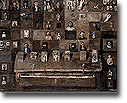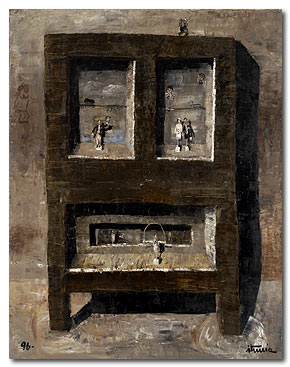Boca Raton Museum of Art,
Sep 08, 2004 - Nov 07, 2004
Boca Raton, Fl, USA
Ignacio Iturria: Everything Has A Face
by Wayne Baerwaldt
In his studio the miniature world he paints is in constant psychological birth through associative mechanisms of recollection. Invigorating both the real and imaginary landscape, Iturria recalls in his paintings the vast surface of a family sofa that becomes an elephantine hulking mass foregrounding a plethora of active and passive painted figures. Through this regenerative process of animation Iturria has not only expelled his parents from the canvas but reality as well --- not necessarily the outer world, but the penetrating "ways of the world" -- reality at its deepest level is abstracted and repopulated with the artist’s own.
From Iturria’s august solitude as an adult, the field of vision for his "inner child" is without limit and the portrait of its inhabitants as innumerable as memory permits. Iturria adopts the grid format reminiscent of abstract art of the 1950s and 60s as an expression of conventional ideas that become a form of languaging. The grids of portraits connected with basic lines of wire are provoking in their display of unity in diversity, while also embodying a bleakness carved by memory that suggests a fear of death, a fear of extinction of earthly body and memory alike. Among the portraits, a recurring schematic elephant takes on monumental proportions and significance. The portrait of human solitude (interchangeable with elephantine solitude and memory) is a way of giving form to modern civilization’s spiritual values largely presented outside the traditional gallery, that of the religious cathedral. Iturria offers glimpses of the religious edifice in Christ’s absence and graffiti stamped replacement: that of Goofy, the Disney character. The cathedral’s high realist portraits of the ecstatic human subject in the thrall of the spirit of the Holy Ghost are notably absent. The cathedral having been replaced by the high-rise condominium, a commercial cathedral whose sales showrooms depict the new ecstasy of ownership in a fabulous place on earth, rather than in heaven. Iturria’s portraits, in all their abstract qualities, are very much of this earth, where the innocence and dementia of childhood are played out. The portraits of family, friends and anonymous others from childhood are primarily pictures and only secondarily the likeness (or analysis) of a face. The quirky caricatures insinuate themselves on window sills, in and around wash basins and even emerge from a water tap’s geyser, faces riding hairpin-like lines of paint that resemble wavering blood trails of human migration.
By any measure Iturria’s figures are absurd characterizations of the human form peering foolishly out the windows of serial urban high-rises or from common domestic furnishings. Yet his surfaces, whether festooned with sub-angular figures or starkly devoid of traces of human contact, present something much more complex. They achieve abstraction by the most radical means, by subterfuge and distraction, and in their depiction of common life.
Iturria’s queer paintings are striking not only for the disarmingly kitsch human forms that dominate many of the paintings but also by their construction. The ‘gullible clown’ playfulness in Iturria’s broken narratives underscore something about the painting process that is much more salient. Their construction has become increasingly sophisticated and deserves critical attention for the incorporation of writing, drawing, carving and even quasi-embroidery in the ink stamping of the graffiti-like cartoon images.
A transcendent form of painting is engaged by Iturria. Ritual application of color may be recognized as the primary building block in Iturria’s painting process and his approach to appearance. The continuity of Iturria’s often limited palette is derived from the range of deep auburn browns reminiscent of the naturally silt and visually dominant Rio de la Plata separating Montevideo from Buenos Aires. The relatively narrow range of color can be understood as a form of identity. Invariably this mischievous artist uses the basic building blocks of tones to challenge himself, maintaining a limited range of colors to illustrate the rich of character of the painting process.
|









